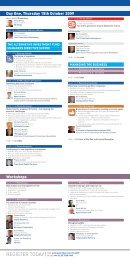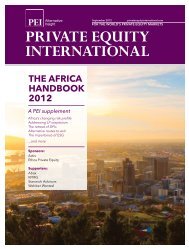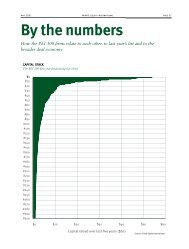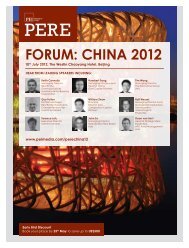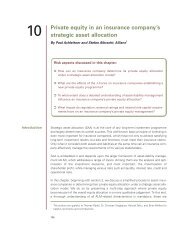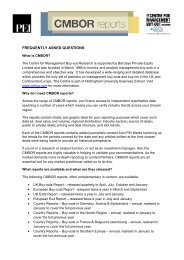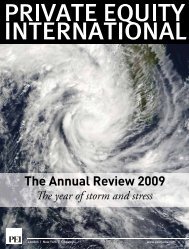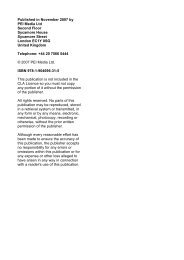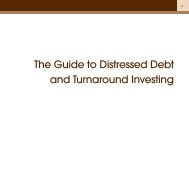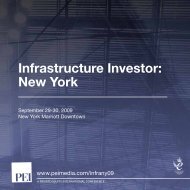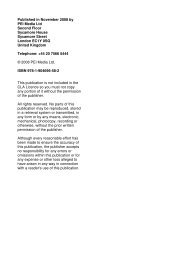Fundamentals of Private Equity and Venture Capital - PEI Media
Fundamentals of Private Equity and Venture Capital - PEI Media
Fundamentals of Private Equity and Venture Capital - PEI Media
Create successful ePaper yourself
Turn your PDF publications into a flip-book with our unique Google optimized e-Paper software.
after deciding to become part <strong>of</strong> a start-up, <strong>and</strong> was introduced through mutual friends. But it<br />
soon became apparent that the company would need a heavyweight, experienced CEO with credibility<br />
on Wall Street.<br />
The first attempts to recruit a CEO highlighted a serious issue – eBay had no VC backing. The fact<br />
that with monthly pr<strong>of</strong>its <strong>of</strong> some $200,000 by early 1997 it did not need external funds was irrelevant;<br />
in Silicon Valley (eBay was based in San Jose, California) it was regarded as an essential<br />
seal <strong>of</strong> approval for a company to have raised venture capital, to have been vetted <strong>and</strong> appraised<br />
<strong>and</strong> to have passed the test. Without this, eBay couldn’t even get an executive search firm to work<br />
for them.<br />
The rule <strong>of</strong> thumb for a venture capital firm appraising an early stage investment was that there<br />
had to be a clear route to making 10 times the original investment within three years. Benchmark<br />
Partners, a venture capital manager itself only two years old, saw this potential in eBay <strong>and</strong> in July<br />
1997 invested $6.7 million for a 25 percent equity stake on terms which valued the company at<br />
$20 million before its investment (the pre-money valuation – see Module 4). eBay never spent<br />
these funds – the money was left untouched in the bank – but capitalised on the contacts, credibility<br />
<strong>and</strong> experience <strong>of</strong> Benchmark’s partners. It was Benchmark who recommended a search<br />
firm to find a CEO, who instructed that firm to pursue a c<strong>and</strong>idate who had declined their first<br />
approach, <strong>and</strong> ultimately played a key role in persuading that c<strong>and</strong>idate – Meg Whitman – that<br />
she should leave her high pr<strong>of</strong>ile, secure role at a major corporation, move her family to California<br />
<strong>and</strong> join a tiny internet start-up.<br />
In September 1998 eBay went public, achieving a listing at a market valuation <strong>of</strong> $2 billion; this<br />
had grown to $21 billion by the spring <strong>of</strong> 1999, producing a return for Benchmark on its $6.7 million<br />
investment <strong>of</strong> 100,000 percent in less than two years (albeit based on highly distorted valuations,<br />
but nevertheless a spectacular return).<br />
Whilst eBay was preparing for its stock market float in 1998, the boo.com team was trying, with<br />
increasing desperation, to find some backers amongst the US venture capital community. A frustrating<br />
round <strong>of</strong> visits to Wall Street, Boston <strong>and</strong> California produced a series <strong>of</strong> rejections <strong>and</strong> a<br />
decision to increase their first round fundraising target from $2 million to $15 million, <strong>and</strong> to<br />
appoint an investment bank. Here was a crucial difference with eBay, who had quickly built a close<br />
relationship with Benchmark, their single investor; from the beginning boo.com was going to raise<br />
funds from a syndicate <strong>of</strong> investors, <strong>and</strong> an investment bank would play a large role both in the<br />
fundraising <strong>and</strong> the subsequent investor relations. This was to have enormous consequences.<br />
The boo.com team’s approach to JP Morgan coincided with a decision by the London <strong>of</strong>fice <strong>of</strong> that<br />
venerable, “old money” institution to explore the internet world, <strong>and</strong> after furious internal debate<br />
they agreed to lead the fundraising. A strength <strong>of</strong> JP Morgan was the ability to introduce, in addition<br />
to mainstream venture capital firms, corporate investors who may be able to add strategic<br />
value. The first round, which closed at $8.8 million in January 1999, included an investment from<br />
Bernard Arnault, the chairman <strong>of</strong> Louis Vuitton Moet Hennessy (LVMH), who assumed the role <strong>of</strong><br />
lead investor.<br />
1999 was characterised by an endless series <strong>of</strong> fundraising – a total <strong>of</strong> $135 million was ultimately<br />
invested – <strong>and</strong> equally endless delays <strong>and</strong> slippages in the launch date for boo.com’s websites.<br />
The team had, in addition to setting itself the phenomenally ambitious task <strong>of</strong> a simultaneous,<br />
multi-country launch, made serious errors in the design <strong>and</strong> development <strong>of</strong> its technology. An<br />
effective single, dominant venture capital investor would have insisted on a simpler strategy,<br />
imposed discipline on the high spending management team (whose excesses in salaries, expenses<br />
<strong>and</strong> over elaborate infrastructure quickly became notorious in London, where they were based)<br />
16 THE FUNDAMENTALS OF PRIVATE EQUITY<br />
COPYING WITHOUT PERMISSION IS UNLAWFUL



